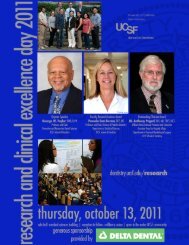magazine - UCSF School of Dentistry - University of California, San ...
magazine - UCSF School of Dentistry - University of California, San ...
magazine - UCSF School of Dentistry - University of California, San ...
You also want an ePaper? Increase the reach of your titles
YUMPU automatically turns print PDFs into web optimized ePapers that Google loves.
24<br />
many diseases, including cancer <strong>of</strong><br />
the mouth. I have seen many <strong>of</strong> these<br />
patients die <strong>of</strong> this terrible disease<br />
and this has provided me the impetus<br />
to identify the causes <strong>of</strong> the disease,<br />
and develop molecular markers that<br />
will impact diagnosis and therapy.<br />
Tell us a bit about your<br />
research.<br />
My research focuses on understanding<br />
the biology <strong>of</strong> oral precancer<br />
and cancer using modern molecular<br />
methods, specifically the application<br />
<strong>of</strong> molecular tests to routine diagnostic<br />
patient material. We are trying to<br />
identify molecular biomarkers that<br />
may allow clinicians to predict which<br />
patients are at risk <strong>of</strong> developing<br />
oral cancer, and will allow for earlier<br />
identification and treatment. We’re<br />
also working on the development <strong>of</strong><br />
molecular tests that will better detect<br />
microscopic cancer cells in regional<br />
lymph nodes.<br />
How does your research fit into<br />
your longer-term career plans?<br />
I work as a pathologist and see<br />
patient biopsy material daily. It would<br />
be nice, one day, not to have to ever<br />
diagnose cancer again.<br />
You might be one <strong>of</strong> the few<br />
faculty members who knows<br />
how to disassemble a car<br />
engine.<br />
That’s right. I financed my university<br />
education as a motor-home<br />
mechanic. This means that not only<br />
can I take apart a motor-home engine,<br />
I actually have first-hand experience<br />
<strong>of</strong> what the word “double wide”<br />
really means.<br />
Janice Lee<br />
Oral and Maxill<strong>of</strong>acial Surgery<br />
Janice Lee, an Assistant<br />
Pr<strong>of</strong>essor <strong>of</strong> Clinical Oral and<br />
Maxill<strong>of</strong>acial Surgery, earned<br />
her DDS degree at UCLA, her<br />
MD at Harvard and then added<br />
an MS at UCLA. She did a residency<br />
in oral and maxill<strong>of</strong>acial<br />
Richard Jordan, Associate Pr<strong>of</strong>essor and Chair, division <strong>of</strong> Oral Medicine, Oral Pathology<br />
and Oral Radiology.<br />
surgery at Massachusetts<br />
General Hospital and Harvard,<br />
followed by a two-year<br />
fellowship in Crani<strong>of</strong>acial and<br />
Skeletal Diseases at the NIH<br />
in Bethesda, Md.<br />
What does your oral surgery<br />
research entail?<br />
I’m working on bone regeneration.<br />
It’s exciting because not many people<br />
are doing it. No one else has studied<br />
rib regeneration to see if we can<br />
influence other parts <strong>of</strong> the body to<br />
regenerate like the rib, where the<br />
bone actually grows back. I am<br />
looking at the characteristics <strong>of</strong><br />
stem cells from the ribs <strong>of</strong> humans<br />
and comparing them to the<br />
regeneration we see on quantitative<br />
CT (computerized tomography),<br />
to figure out what it is about the rib<br />
that allows it to grow, a characteristic<br />
that doesn’t typically happen in any<br />
other bone in the body.<br />
What is the benefit <strong>of</strong><br />
regeneration over traditional<br />
bone-grafting approaches?<br />
With large bone irregularities or<br />
deficiencies in the head and neck —<br />
those caused by a congenital<br />
anomaly, such as hemifacial<br />
microsomia, or bone loss through<br />
trauma or tumor removal — no<br />
matter how long you wait, the<br />
human body won’t fill in that space.<br />
Surgeons have to use bone from<br />
another area <strong>of</strong> the body, most commonly<br />
the hip and rib, to reconstruct<br />
defects in the crani<strong>of</strong>acial skeleton.<br />
You’re effectively robbing from<br />
Peter to pay Paul in that case. No<br />
one has yet found a way to fix the<br />
defects other than to take from these<br />
sites. When you take bones from<br />
other areas <strong>of</strong> the body, you create a<br />
second surgical site and, with it, a<br />
new defect. This can be particularly<br />
problematic in the elderly, who <strong>of</strong>ten<br />
naturally develop complications in the<br />
hip area later in life or in children who<br />
naturally have smaller bones and<br />
fewer harvesting sites. Through this<br />
research, I am studying areas <strong>of</strong> the<br />
body that regenerate on their own<br />
without any assistance — the rib and,<br />
occasionally, the pediatric mandible.<br />
I’m looking at what we can do to the<br />
mandible to make it “think” that it too<br />
can form bone. Though growing a<br />
mandible from a few stem cells<br />
seems far into the future, it is an<br />
exciting area <strong>of</strong> research and one that<br />
can make a big difference in patient<br />
care and the way we will practice in<br />
the future. I’m also interested in<br />
developing an animal model to further<br />
study this ability to grow bone.




